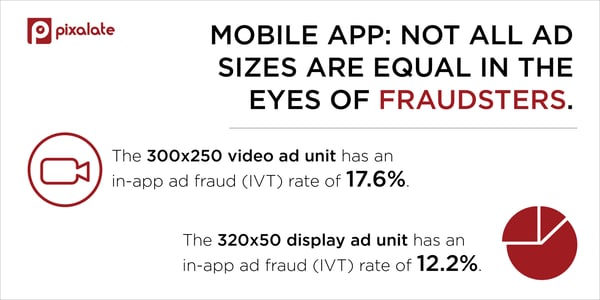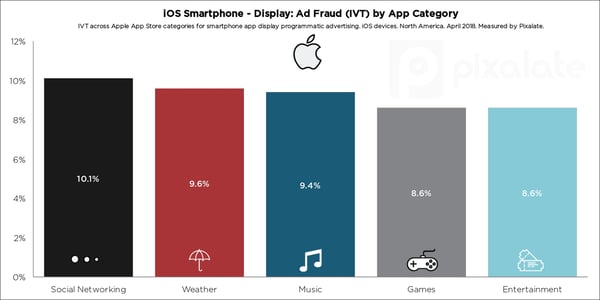
This week's review of ad fraud and quality in the digital advertising space.

Pixalate's latest research reveals which mobile in-app ad sizes have the highest ad fraud (IVT) rates across display and video advertising. The 300x250 video ad size has an invalid traffic (IVT) rate of 17.6% in-app on smartphones, while the 320x480 video ad size has an ad fraud rate of 17.2%.

Pixalate examines invalid traffic ("IVT") rates across popular iOS app categories. The 'Social' app category has the highest display IVT rate on iPhones (10.1%) and iPads (12.6%). The 'Weather' (40.2%) and 'Music' (35%) have high video IVT rates, especially when compared to the display IVT rates in those categories. Learn more.

The New York Times goes deep into the world of fake YouTube views, noting that "plays can be bought for pennies and delivered in bulk, inflating videos’ popularity and making the social media giant vulnerable to manipulation." The article adds: "While YouTube says fake views represent just a tiny fraction of the total, they still have a significant effect by misleading consumers and advertisers."

"We expect the number of US cord-cutters — adults who have ever cancelled a pay TV service and continue without it — to climb by 32.8% this year to 33.0 million," wrote eMarketer. "Meanwhile, the number of subscription OTT video service viewers will rise to 170.1 million, equating to 51.7% of the US population."

"[H]ackers used a Chipotle ad developed in HTML5 to carry out a malware attack on June 11, 2018 that lasted for more than 7.5 hours until the exchange blocked the creative," reported MediaPost. "One in every 200 programmatic impressions acted as a malicious redirect to attack those viewing the ads. An additional three in 200 were fraudulent in-banner video (IBV) impressions, where the publisher’s display inventory was being misrepresented to video advertisers."
Sign up for our blog to stay updated with new stats, trends, and analysis of digital ad fraud.
*By entering your email address and clicking Subscribe, you are agreeing to our Terms of Use and Privacy Policy.
These Stories on Weekly Recaps
*By entering your email address and clicking Subscribe, you are agreeing to our Terms of Use and Privacy Policy.

Disclaimer: The content of this page reflects Pixalate’s opinions with respect to the factors that Pixalate believes can be useful to the digital media industry. Any proprietary data shared is grounded in Pixalate’s proprietary technology and analytics, which Pixalate is continuously evaluating and updating. Any references to outside sources should not be construed as endorsements. Pixalate’s opinions are just that - opinion, not facts or guarantees.
Per the MRC, “'Fraud' is not intended to represent fraud as defined in various laws, statutes and ordinances or as conventionally used in U.S. Court or other legal proceedings, but rather a custom definition strictly for advertising measurement purposes. Also per the MRC, “‘Invalid Traffic’ is defined generally as traffic that does not meet certain ad serving quality or completeness criteria, or otherwise does not represent legitimate ad traffic that should be included in measurement counts. Among the reasons why ad traffic may be deemed invalid is it is a result of non-human traffic (spiders, bots, etc.), or activity designed to produce fraudulent traffic.”

